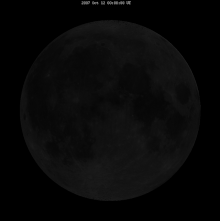|
Hjúki and Bil
 In Norse mythology, Hjúki (Old Norse: [ˈhiu̯ːke], possibly meaning "the one returning to health"[1]) and Bil (O.N.: [ˈbil], literally "instant"[2]) are a brother and sister pair of children who follow the personified Moon, Máni, across the heavens. Both Hjúki and Bil are solely attested in the Prose Edda, written in the 13th century by Snorri Sturluson. Scholarly theories that surround the two concern their nature, their role as potential personifications of the craters on the Moon or its phases, and their relation to later folklore in Germanic Europe. Bil has been identified with the Bilwis, an agriculture-associated figure that is frequently attested in the folklore of German-speaking areas of Europe. AttestationsIn chapter 11 of the Prose Edda book Gylfaginning, the enthroned figure of High states that two children by the names of Hjúki and Bil were fathered by Viðfinnr. Once while the two were walking from the well Byrgir (Old Norse "Hider of Something"[3]) — both of them carrying on their shoulders the pole Simul (Old Norse, possibly meaning "eternal"[4]) that held the pail Sæg between them – Máni took them from the Earth, and they now follow Máni in the heavens, "as can be seen from the earth".[5] Hjúki is otherwise unmentioned, but Bil receives recognition. In chapter 35 of Gylfaginning, at the end of a listing of numerous other goddesses in Norse mythology, both Sól (the personified Sun) and Bil are listed together as goddesses "whose nature has already been described".[6] Bil appears twice more in the Prose Edda book Skáldskaparmál. In chapter 75, Bil appears within another list of goddesses,[7] and her name appears in chapter 47 in a kenning for "woman".[8] Theories Identification and representationAs the two are otherwise unattested outside Snorri's Prose Edda, suggestions have been made that Hjúki and Bil may have been of minor mythic significance, or that they were made up outright by Snorri, while Anne Holtsmark (1945) posits that Snorri may have known or had access to a now lost verse source wherein Hjúki and Bil personified the waxing and waning moon. Holtsmark further theorizes that Bil may have been a dís (a type of female deity).[9] Scholars have theorized that Hjúki and Bil may represent lunar activity, including that they may represent the phases of the moon or may represent the craters of the Moon. 19th century scholar Jacob Grimm rejects the suggestion that Hjúki and Bil represent the phases of the moon, and states that Hjúki and Bil rather represent the craters on the Moon seen from the Earth. Grimm says that the evidence for this "is plain from the figure itself. No change of the moon could suggest the image of two children with a pail slung over their shoulders. Moreover, to this day the Swedish people see in the spots of the Moon two persons carrying a big bucket on a pole."[10] Grimm adds that:
Grimm gives further examples from Germanic folklore until the time of his writing (the 19th century) and notes a potential connection between the German word wadel (meaning the full moon) and the dialectal employment of the word for "brushwood, twigs tied up in a bundle, esp[ecially] fir-twigs, wadeln to tie up brushwood", and the practice of cutting wood out in the full moon.[10] Benjamin Thorpe agrees with the theory of Hjúki and Bil as the personified shapes of Moon craters.[11] Rudolf Simek states that the obscurity of the names of the objects in the tale of Hjúki and Bil may indicate that Snorri derived them from a folktale, and that the form of the tale of the Man in the Moon (featuring a man with a pole and a woman with a bushel) is also found in modern folklore in Scandinavia, England, and Northern Germany.[12]  In both the story Hjúki and Bil found in the Icelandic Prose Edda and the English nursery rhyme "Jack and Jill", two children, one male and one female, fetch a pail of water, and the pairs have names that have been perceived as phonetically similar. These elements have resulted in theories connecting the two,[13] and the notion has had some influence, appearing in school books for children from the 19th century and into the 20th century.[14] A traditional form of the rhyme reads:
BilwisA figure by the name of Bilwis is attested in various parts of German-speaking Europe starting in the 13th century. Scholar Leander Petzoldt writes that the figure seems to stem from the goddess and over time saw many changes, later developing "an elfin, dwarfish aspect and the ability to cripple people or cattle with the shot of an arrow" (such as in Wolfram von Eschenbach's 13th century poem "Willehalm"). Petzoldt further surveys the development of the figure:
ToponymsThe village of Bilsby in Lincolnshire, England (from which the English surname Billing derives) has been proposed as having been named after Bil.[13] See also
Notes
References
|
